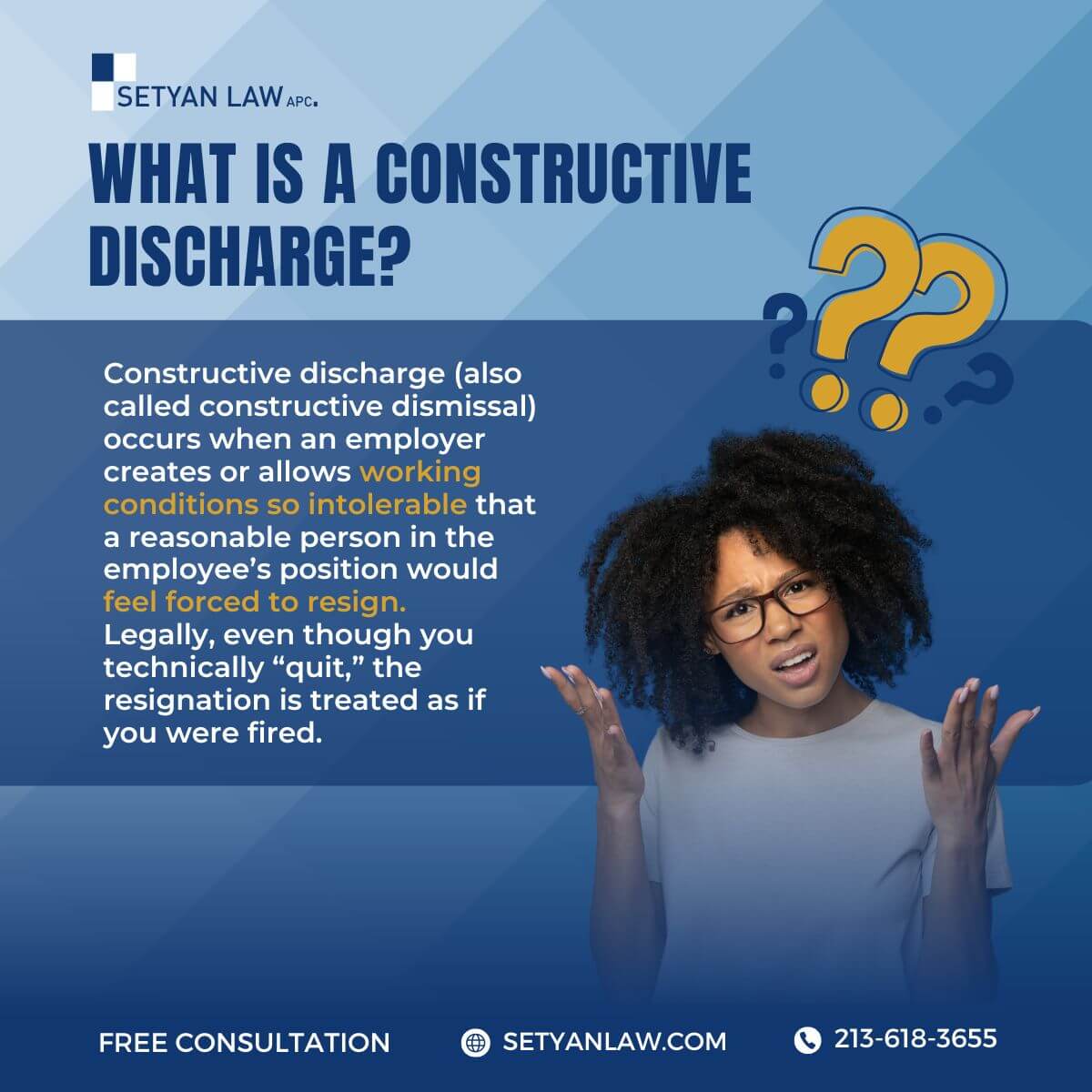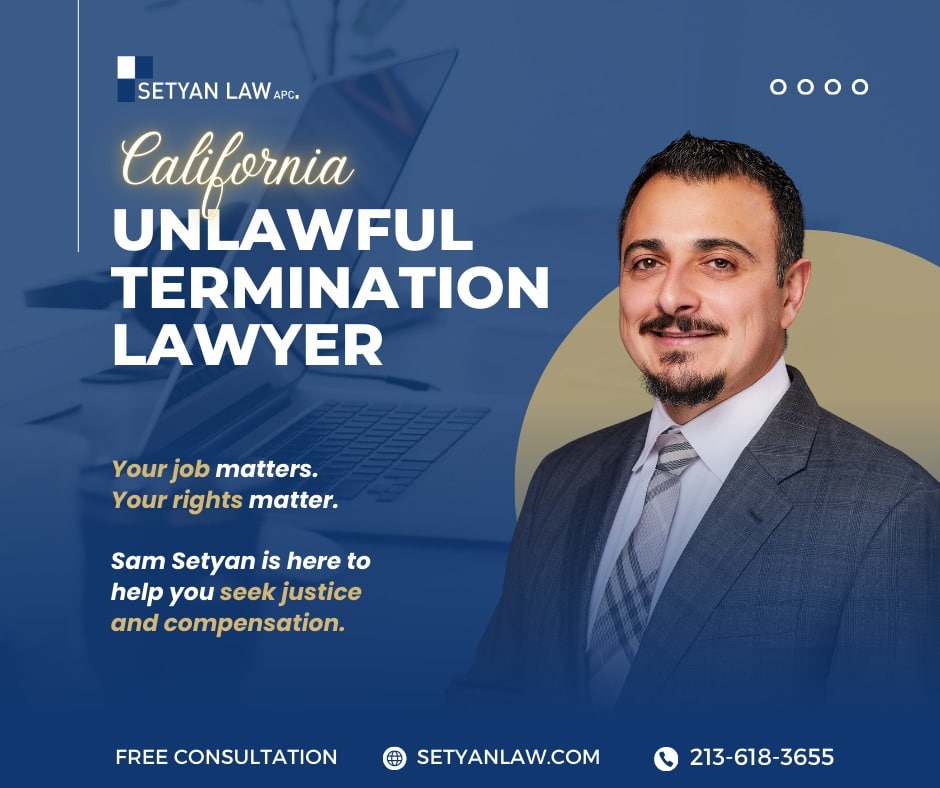Updated September 20, 2025
Constructive Dismissal in Employment Law
Constructive dismissal is a significant legal concept that affects employees in California. It occurs when an employee resigns due to intolerable working conditions created by the employer. This situation can arise from various factors, including harassment, significant changes in job responsibilities, or a hostile work environment. Understanding the nuances of constructive dismissal is essential for employees who may find themselves in such circumstances.
What is Constructive Dismissal?
Constructive dismissal refers to a situation where an employee feels compelled to resign because of their employer’s actions. Unlike traditional termination, where an employer explicitly ends the employment relationship, constructive dismissal happens when the work environment becomes so unbearable that the employee has no choice but to leave. This can include:
- Harassment: Continuous bullying or discrimination can create a toxic atmosphere.
- Unreasonable Changes: Employers may alter job duties, compensation, or working conditions without consent.
- Lack of Support: Failure to address workplace complaints can lead to feelings of isolation and frustration.
Legal Framework
In California, constructive dismissal is not defined by a single statute but is recognized through various employment laws and court rulings. Employees must demonstrate that their employer’s actions constituted a breach of the employment contract, leading to their resignation.
Proving Constructive Dismissal
To establish a claim for constructive dismissal, employees must meet certain criteria:
Intolerable Conditions: The employee must show that the working conditions were so severe that a reasonable person in a similar situation would feel compelled to resign.
Employer’s Conduct: The actions or failures of the employer must directly contribute to the intolerable conditions. This could include:
- Significant changes to job duties or pay.
- Failure to prevent harassment or discrimination.
- Creating a hostile work environment.
Resignation Timing: The employee must resign shortly after the intolerable conditions arise. Delaying resignation may weaken the claim, as it could suggest acceptance of the new conditions.
Evidence Collection
Gathering evidence is crucial in a constructive dismissal case. Employees should document:
- Instances of harassment or discrimination.
- Changes in job responsibilities or pay.
- Any communications with the employer regarding complaints or concerns.
Legal Protections for Employees
California law provides various protections for employees facing constructive dismissal. These include:
- Anti-Discrimination Laws: Employees cannot be discriminated against based on race, gender, age, or other protected characteristics.
- Whistleblower Protections: Employees who report illegal activities or unsafe working conditions are protected from retaliation.
- Contractual Rights: If an employee has a written contract, any violation of the terms may constitute constructive dismissal.
Seeking Legal Recourse
If an employee believes they have been constructively dismissed, they may pursue legal action against their employer. This can include filing a complaint with the Equal Employment Opportunity Commission (EEOC) or pursuing a civil lawsuit for wrongful termination.
Common Signs of Constructive Dismissal
Identifying constructive dismissal can be challenging. However, certain signs may indicate that an employee is facing intolerable conditions:
- Sudden Performance Changes: Unexplained negative changes in performance reviews can signal underlying issues.
- Compensation Changes: Decreased pay or benefits without justification may indicate an attempt to force resignation.
- Job Duties Alteration: Significant changes to an employee’s role or responsibilities can create a sense of instability.
- Lack of Response to Complaints: Ignoring grievances raised by employees can worsen an already challenging environment.
Employee Rights
Employees have the right to work in an environment free from harassment and discrimination. If an employee experiences constructive dismissal, they have the right to seek compensation for lost wages and damages.
Legal Defenses Employers May Use
Employers may contest claims of constructive dismissal by arguing:
- Conditions Were Not Intolerable: They might assert that the employee’s complaints do not reflect a hostile work environment.
- Employee Acceptance: Employers may argue that the employee accepted the new conditions by continuing to work for an extended period after the changes.
- Unrelated Performance Issues: They might claim that any performance issues were unrelated to the alleged constructive dismissal.
Preparing for a Claim
Employees considering a claim for constructive dismissal should consult with an employment attorney. Legal professionals can help navigate the complexities of employment law and provide guidance on the best course of action.
Filing a Constructive Dismissal Complaint
If an employee decides to file a complaint, they can follow these steps:
- Consult an Attorney: Seek legal advice to understand the rights and potential outcomes.
- Gather Evidence: Collect documentation related to the employment situation and any communications with the employer.
- File with the EEOC: Submit a complaint if the dismissal is based on discrimination or harassment.
- Pursue Legal Action: If necessary, file a lawsuit against the employer for constructive dismissal.
Importance of Timeliness
It is crucial to act quickly when pursuing a constructive dismissal claim. California law imposes strict deadlines for filing complaints, so employees should not delay in seeking legal assistance.
The Role of Employment Lawyers
Employment lawyers play a vital role in helping employees navigate constructive dismissal claims. They can:
- Provide legal advice on the merits of a case.
- Assist in gathering evidence and preparing documentation.
- Represent employees in negotiations or court proceedings.
Finding the Right Lawyer
When searching for an employment attorney, employees should consider:
- Experience: Look for lawyers with a track record in handling constructive dismissal cases.
- Reputation: Research reviews and testimonials from past clients.
- Consultation: Many lawyers offer free initial consultations, allowing employees to assess their options.
Conclusion
Constructive dismissal is a serious issue that can have significant implications for employees in California. Understanding the legal framework, recognizing the signs, and knowing how to seek help are crucial for anyone facing intolerable working conditions. If you believe you are experiencing constructive dismissal, it is essential to consult with an employment lawyer who can advocate for your rights and help you navigate the complexities of employment law.
If you’re employed by a California employer, contact an expert wrongful termination attorney first, for expert assistance regarding your case. Call today for a free and confidential consultation.








